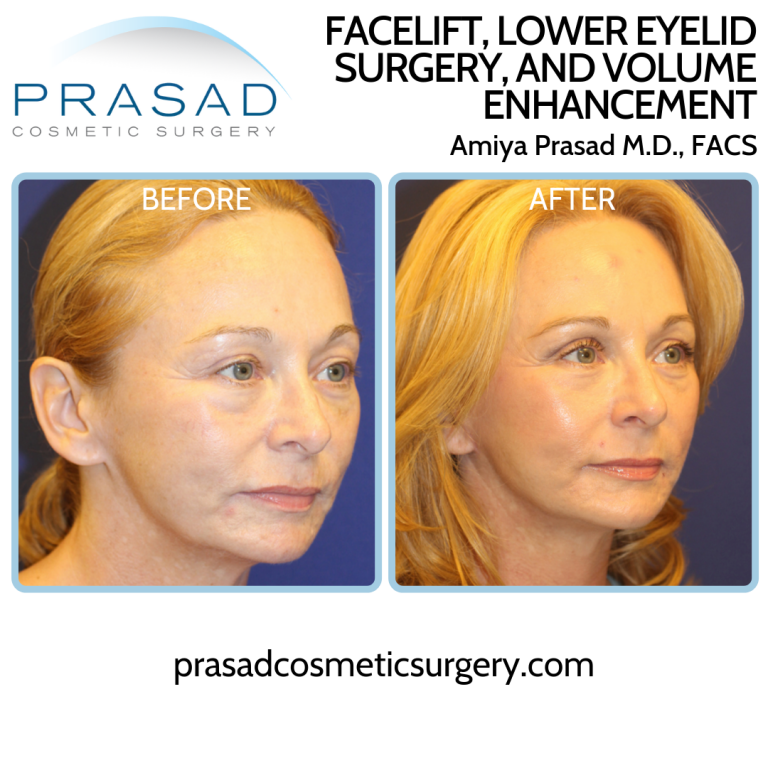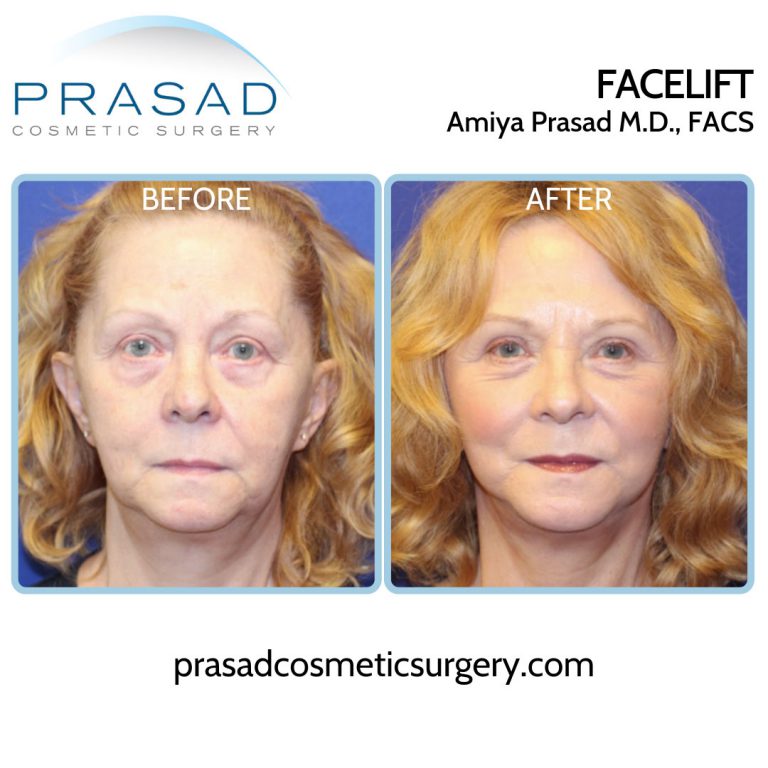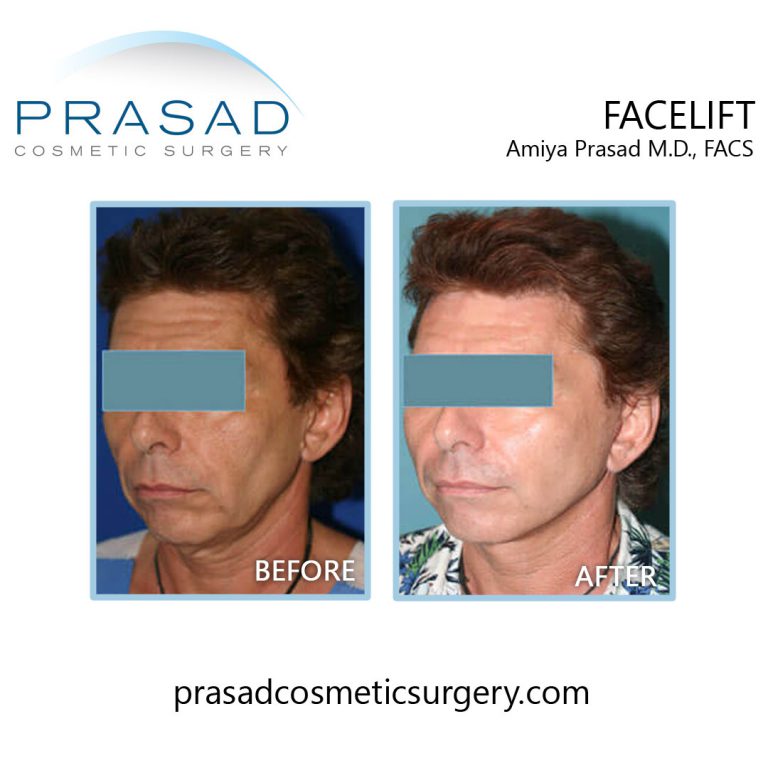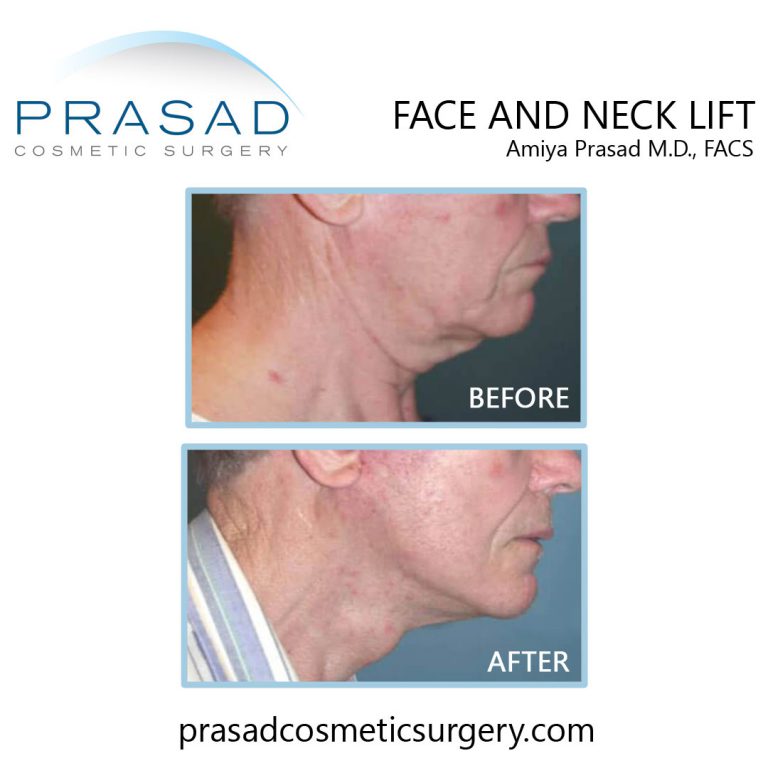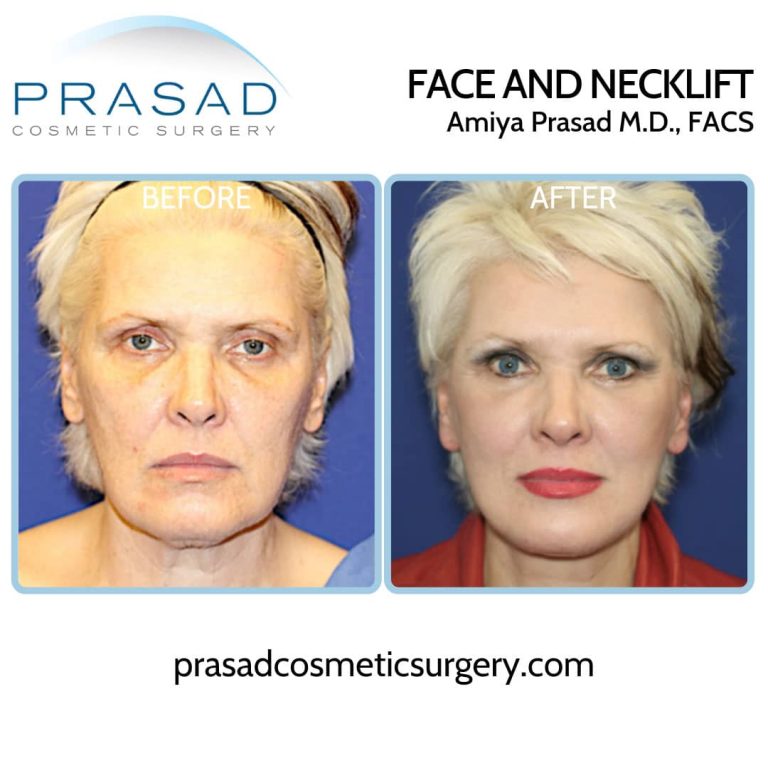Schedule Your Consultation with Dr. Prasad Here
- Home
- About Dr. Prasad
- Face & Eyes
Eyelifts
- Eyelid Surgery
- Eye lift Before and After Photos
- Asian Eyelid Surgery
- Upper Eyelid Surgery
- Upper Eyelid Hollow / Lower Brow Hollowing
- Under Eye Bag Surgery
- Eyelid Ptosis Surgery Old
- Transconjunctival Blepharoplasty
- Under Eye Fillers
- Eyelid Surgery Revision Specialist
- Thyroid Eye Disease
- Tear Trough Implants
- Eye Lift Questions and Answers
- Body
- Injectables
- Laser
- Hair Restoration
- Photos
- Hair Restoration Before and After Photos
- Eye lift Before and After Photos
- Upper Blepharoplasty Before and After
- Ptosis Surgery Before And After
- Facelift Before and After Photos
- Lip Enhancement Before and After Photos
- Under Eye Filler Before and After
- Blepharoplasty Before and After
- Lower Blepharoplasty Before and After Photos
- Eyelid Surgery Before and After
- Double Eyelid Surgery Before and After
- Contact Us
- Home
- About Dr. Prasad
- Face & Eyes
Eyelifts
- Eyelid Surgery
- Eye lift Before and After Photos
- Asian Eyelid Surgery
- Upper Eyelid Surgery
- Upper Eyelid Hollow / Lower Brow Hollowing
- Under Eye Bag Surgery
- Eyelid Ptosis Surgery Old
- Transconjunctival Blepharoplasty
- Under Eye Fillers
- Eyelid Surgery Revision Specialist
- Thyroid Eye Disease
- Tear Trough Implants
- Eye Lift Questions and Answers
- Body
- Injectables
- Laser
- Hair Restoration
- Photos
- Hair Restoration Before and After Photos
- Eye lift Before and After Photos
- Upper Blepharoplasty Before and After
- Ptosis Surgery Before And After
- Facelift Before and After Photos
- Lip Enhancement Before and After Photos
- Under Eye Filler Before and After
- Blepharoplasty Before and After
- Lower Blepharoplasty Before and After Photos
- Eyelid Surgery Before and After
- Double Eyelid Surgery Before and After
- Contact Us
Facelift Quick Links
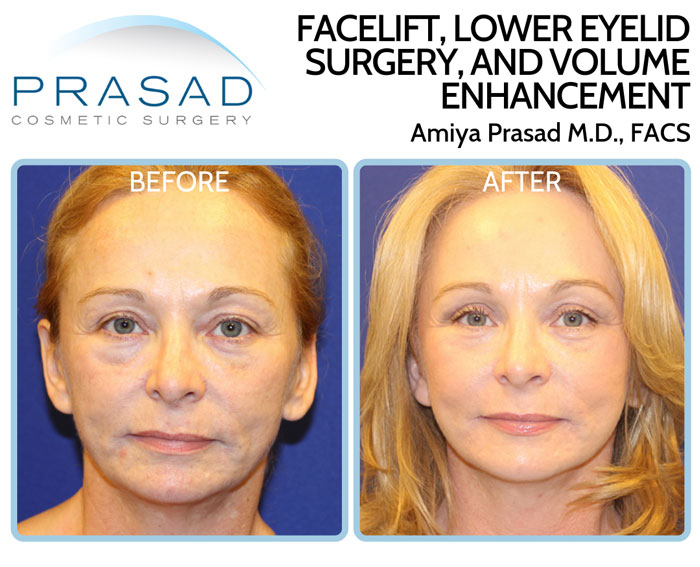
As a renowned facial cosmetic surgeon with precision artistry, Dr. Amiya Prasad’s approach to facelifts and all other cosmetic procedures is to maintain your unique facial characteristics so you will still look like yourself, but about 10 years younger.
Dr. Prasad has dedicated his career to performing full, extensive facelift surgery for the best results possible, but with quicker recovery techniques such as using local anesthesia with LITE™ intravenous (IV) sedation.
Dr. Prasad believes a good facelift should improve a person’s look in a subtle way. People might say you look refreshed or vibrant, but it should not be obvious that you had cosmetic surgery.
Facelift Before and After Patient Photos
DR. PRASAD’S FACELIFT STYLE IS ABOUT RETAINING UNIQUE FACIAL CHARACTERISTICS, BUT LOOKING NATURAL AND CONSIDERABLY YOUNGER.
What is Facelift Surgery?
Facelift surgery or rhytidectomy, is a procedure that lifts and tightens sagging skin, muscles, and deeper tissues of the face to achieve a more youthful appearance. Over the years, facelift techniques have significantly evolved to ensure better results with less downtime.
Rhytidectomy includes different types of procedures that lift and tighten the sagging skin, reposition soft tissue, and tighten the muscle foundation of the face, specifically the SMAS (superficial musculoaponeurotic system), with lifting and tightening seen in the cheeks, jawline, and neck.
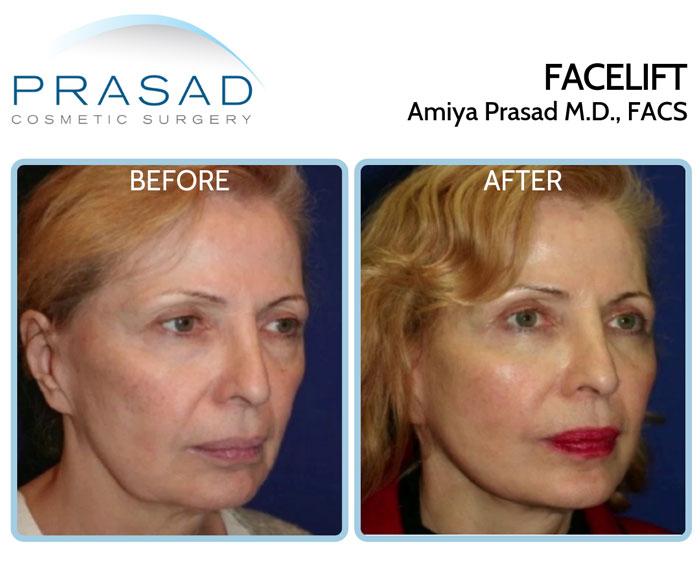

Benefits of Facelift
Having facelift surgery can improve your appearance so you can look 10-15 years younger. An artistically performed facelift can boost your self-esteem and confidence both socially and professionally.
A facelift procedure will:
- Restore sagging or loose skin of the face or neck, resulting in improvement in jawline and neck definition.
- Tighten the facial structure under the skin through the musculature and soft tissue.
- Improve the contour of the face.
What is a Mini Facelift?
A mini facelift, also known as a short scar facelift because of the shorter incision, is a less invasive procedure in which the neck does not require extensive lifting, so it can be performed through a shorter incision.
Mini facelifts are appropriate for people who want to lift a sagging jawline, but don’t have skin, deep tissue, or muscle laxity at the neck.
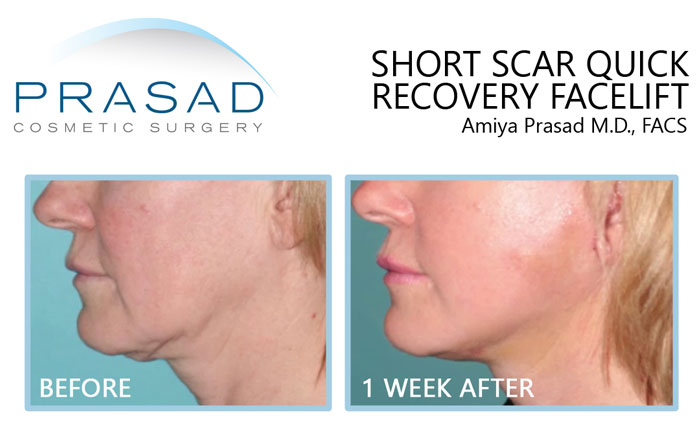
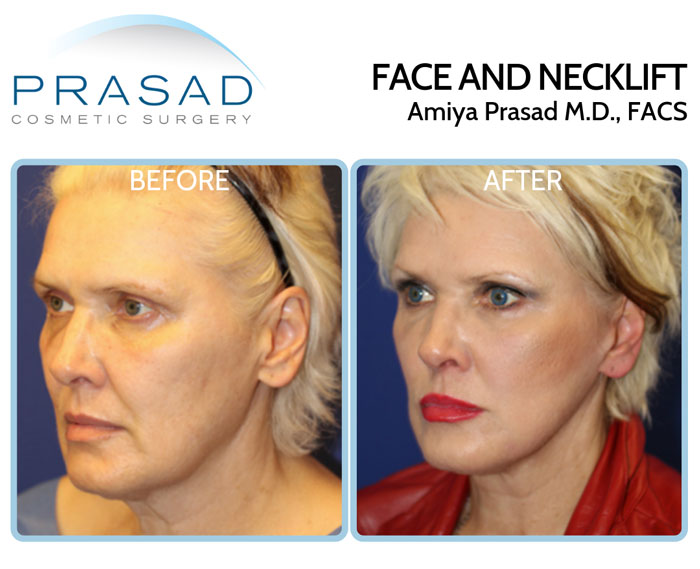
What is a “SMAS” Facelift?
The term “SMAS” stands for “superficial musculoaponeurotic system,” which is essentially a layer of muscle that needs to be tightened during a facelift. It serves as the foundation for the skin, providing the necessary structure for a natural, smooth result.
A facelift involves lifting the sagging SMAS, and skin from the upper cheek to the jawline and part of the neck. Dr. Prasad’s facelifts include tightening the SMAS, and the deeper layers beneath it (called a deep-plane facelift) for more effective, and longer-lasting results.
What is a Deep Plane Facelift?
The deep-plane facelift refers to a procedure that goes into a deeper layer beneath the skin and beneath the SMAS. Performing a facelift from this deep tissue area often results in a longer lasting facelift.
While some cosmetic surgeons claim exclusivity and expertise with the deep plane facelift, it is actually a well-established technique practiced by experienced cosmetic surgeons who perform all types of facial surgeries.
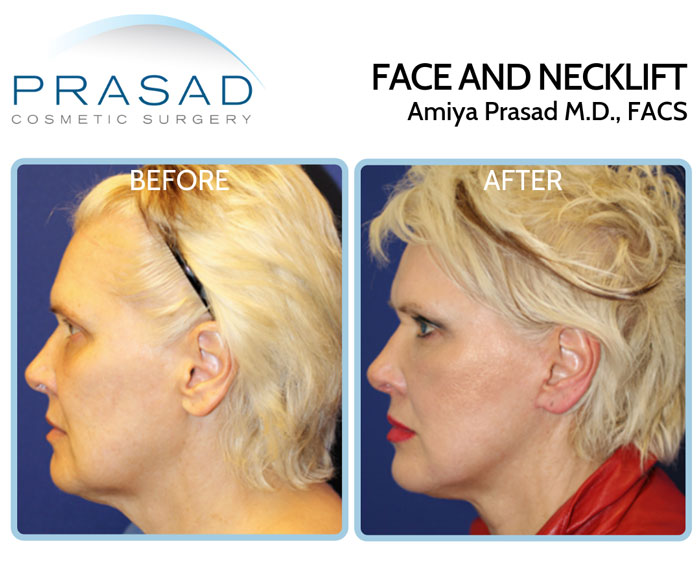
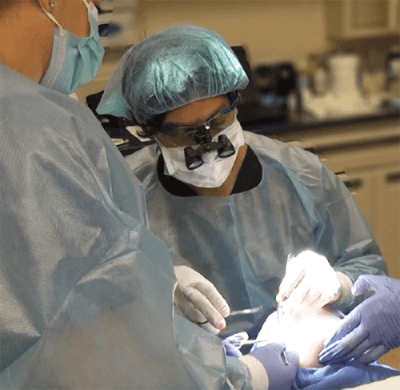
In contrast to many cosmetic surgeons performing the deep-plane facelift using general anesthesia, facial cosmetic surgeon Dr. Amiya Prasad performs the deep plane facelift using local anesthesia with his sedation method called LITE™ IV sedation (local anesthesia – intravenous – tumescent – ease of recovery).
This approach makes the surgical experience much easier on patients when compared to general anesthesia. Dr. Prasad has observed a faster healing process, and greater ease in recovery in using local anesthesia for facelift surgery.
Dr. Amiya Prasad, a Board-certified cosmetic cosmetic and reconstructive surgeon, and a recognized leader in facial rejuvenation surgery, including eyelid and facelift procedures.
Dr. Prasad is a Diplomate of the American Board of Cosmetic Surgery, and a member of the American Society of Plastic and Reconstructive Surgery, with over 25 years of experience in his medical practice. He has also contributed to the field as a clinical instructor in facelift surgery, and as the author of “The Fine Art of Looking Younger.”
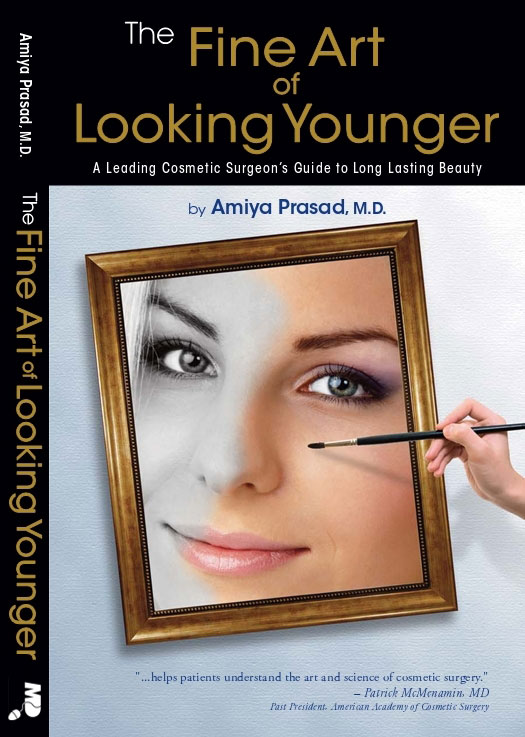
How is the Facelift Procedure Done?
Dr. Amiya Prasad performs all facelift procedures under his own approach using local anesthesia with LITE™ IV sedation for his patients, a great advantage for busy people who want to improve their appearance and confidence, without the risks, discomfort, and extended downtime associated with general anesthesia.
Make the Right Choice About the Type of Anesthesia
Facelifts are extensive surgical procedures that last for hours, and most cosmetic surgeons perform facelifts under general anesthesia. General anesthesia means:
- The patient is unconscious and breathes with the aid of a respirator
- Higher rate of surgical and anesthesia-related complications
- Longer recovery times due to the systemic effects of prolonged general anesthesia
- Generally associated with more swelling and bruising from events such as severe coughing spells after the tube is removed from the throat
- Nausea and vomiting after surgery due to the use of opioid medications such as high dose fentanyl
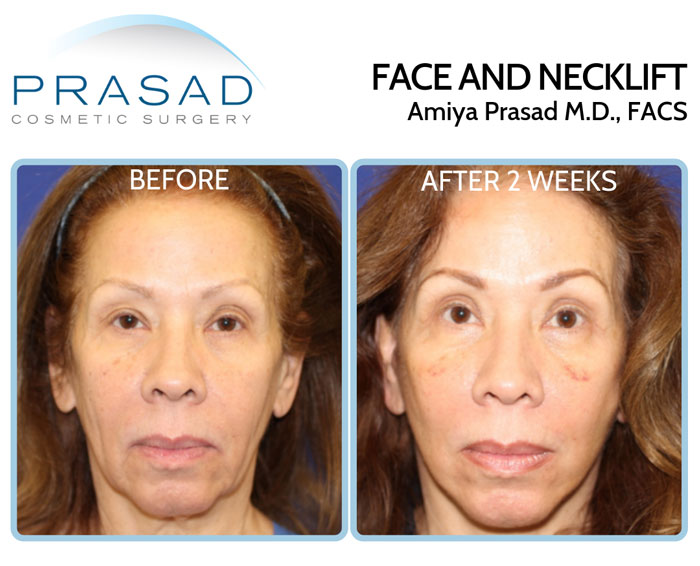
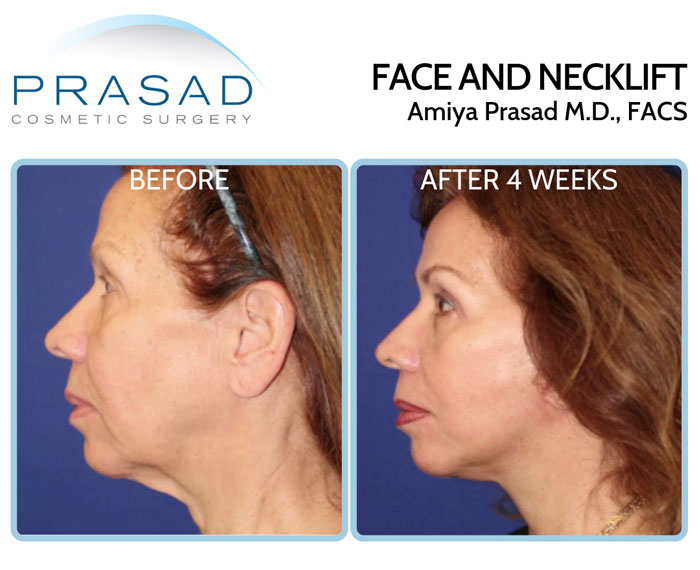
Are You a Candidate for a Facelift?
A facelift improves one’s appearance and can boost self-esteem, but it is not for everyone. Good candidates have:
- Sagging or loose skin on the face or neck
- Good overall health
- Skin elasticity and suppleness
- Strong bone structure
- Realistic expectations
Some patients might be able to reach their aesthetic goals with a less invasive procedure, such as a chemical peel, microdermabrasion, or the Micro Fractional CO2 Laser Treatment. Some people in their 40s to 50s may have no or limited skin laxity, but are losing facial volume can opt for the Y Lift®/ Structural Volumizing.
This specialized procedure places filler at a deeper level than traditional filler application, for stronger support at the bone level,versus dermal/soft tissue placement where only a limited amount of filler can be placed before looking doughy. Structural Volumizing at the stronger bone and muscle level provides a wider framework for the overlying skin and soft tissue, thereby providing a significant “lift” for people who are not yet candidates for facelift surgery.
Patients who understand both the possibilities and limitations of facelifting tend to be happier with the results that can be achieved by a facelift. A proper consultation with Dr. Prasad will help determine if you are a candidate for a facelift surgery, volume augmentation, or another procedure more appropriate for their unique needs, and time of life.
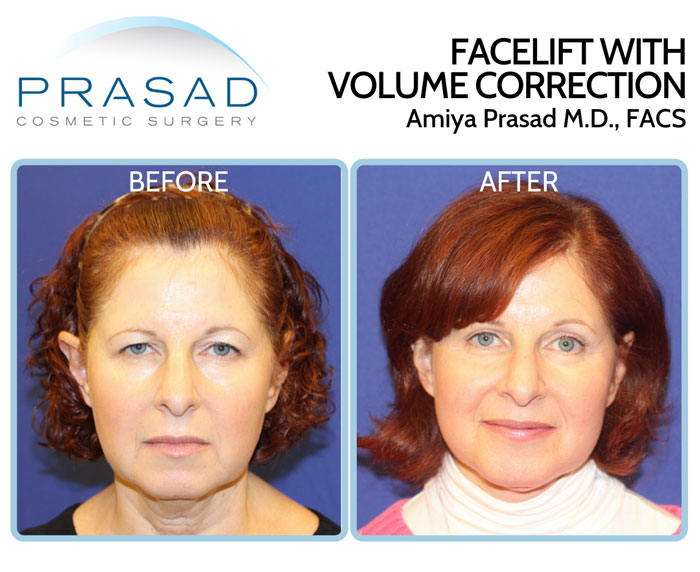
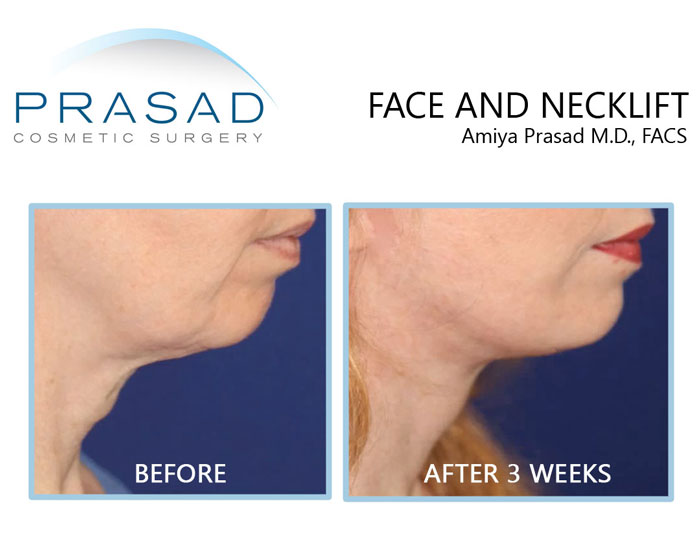
Facelift Recovery
Quick Recovery Facelift – Dr Prasad’s Innovative Method
Dr. Amiya Prasad’s Quick Recovery Facelift is designed for those with busy lifestyles who want a natural look without the obvious signs of surgery. Patients often want effective results, but without the long recovery time, or results that make them look unrecognizable, so Dr. Prasad developed this procedure to provide his patients with minimal risk, maximum gain, and quick recovery.
The Quick Recovery Facelift takes 2 to 3 hours, and is performed using local anesthesia with LITE™ sedation. Incisions are made along the ear, and patients can return home about an hour after the procedure, with only a small bandage. Functional recovery before they can return to work, and their typical routine usually takes about one week.
“Quick Recovery Facelift” vs. “The Traditional Facelift” & “The MACS Facelift”
| Traditional Facelift | MACS Facelift | Dr. Prasad’s Facelift |
|---|---|---|
| 4 hour procedure | 2-4 hour procedure | 2-3 hour procedure |
| Typically performed in hospital or operating room with overnight stay. | Performed in a hospital or operating room with an overnight stay. | Performed in state of the art office suites. Go home about 1 hour after the procedure. |
| General anesthesia | General anesthesia often used | Local anesthesia (Intravenous sedation as needed) |
| Large scar behind ear-Sometimes requires loss of hairline in that area | Incision scar next to outer corner of the eyelid can be long and obvious | Smaller scar found typically in crease between ear and face and slightly around the earlobe (customized to the degree of loose skin) |
| Large bandages over face that need to be changed periodically. Drains left in for the first few days. | Large bandages on the head and neck until the day after surgery. | Small bandage and antibiotic ointment. Drains not necessary. Comes off in under a week. |
| 4 week healing period | 2-3 week healing period | On average 1 week healing period |
| Risk of plastic appearance | Cheeks look round and puffy. | Natural appearance |
How Long is Facelift Recovery?
Dr. Prasad’s Quick Recovery method helps patients return to their normal routines more quickly than traditional facelifts. Most patients recover enough to return to work and normal activities about a week after surgery, experiencing minimal bruising and swelling. Some patients return to work within a week, and report little to no significant pain or discomfort.
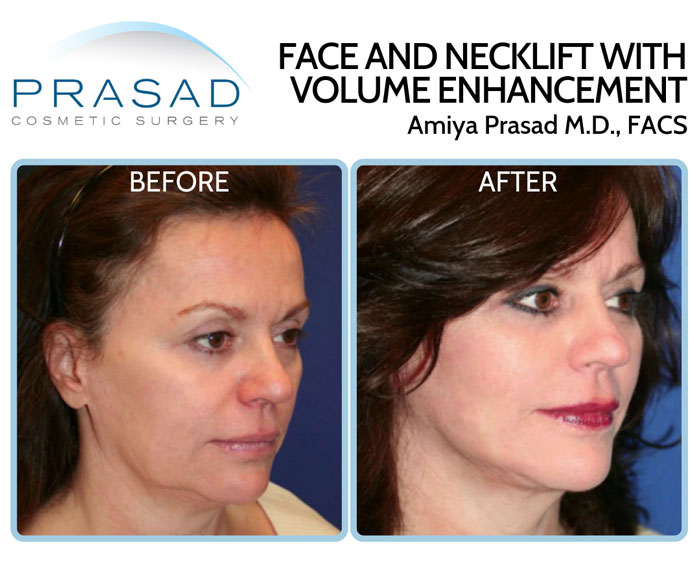
Procedures that Complement a Facelift
The face lifting procedure can accompany other procedures, such as a neck lift, an eyebrow lift or eyelid lift, or a fractionated or fully ablative laser. A neck lift raises the loose skin from the jawline to the lower part of the neck. Although a facelift does not include lifting of the eyebrows or eyelids, it can be accomplished by having an eyelift or brow lift done at the same time. Eyelid rejuvenation can complement the facelift by achieving a desired shape and balance to the face.
Depending on skin type, and depth of treatment, laser or radiofrequency treatment can also help achieve remarkable results in the skin when combined with a facelift, with little downtime. The heat and laser technologies diminish the appearance of wrinkles, scars (such as acne scars), and discoloration (such as from sun damaged skin) while it smooths and tightens the surface of one’s skin, and boosts collagen production in the skin for up to six months.
Patient Reviews
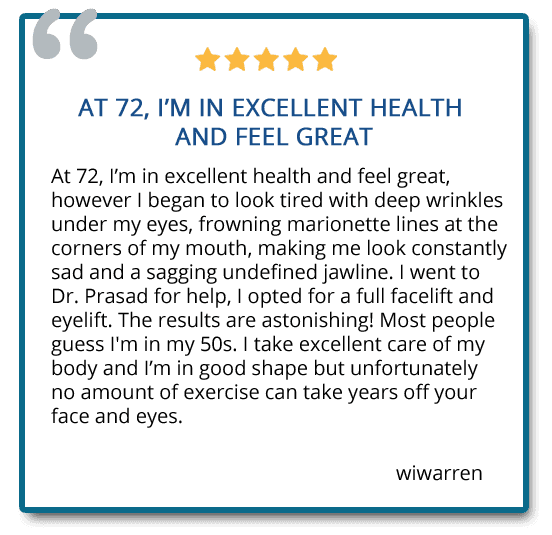
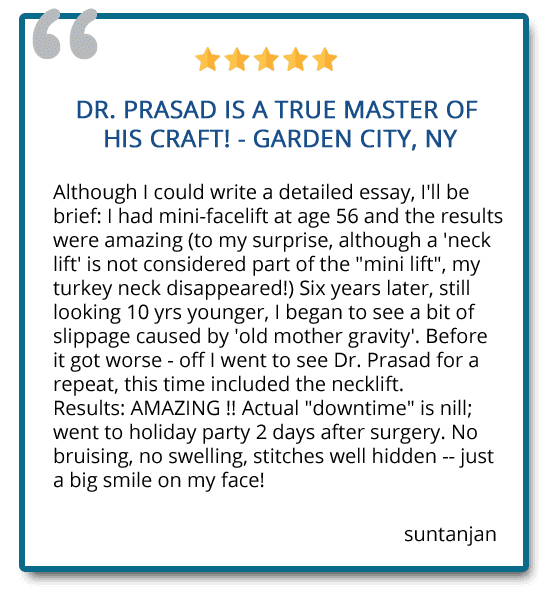
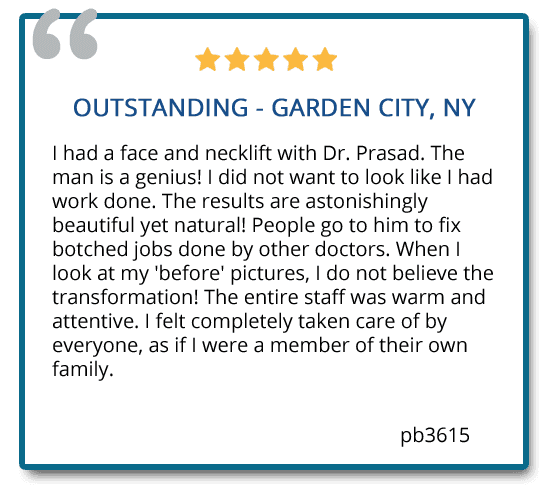
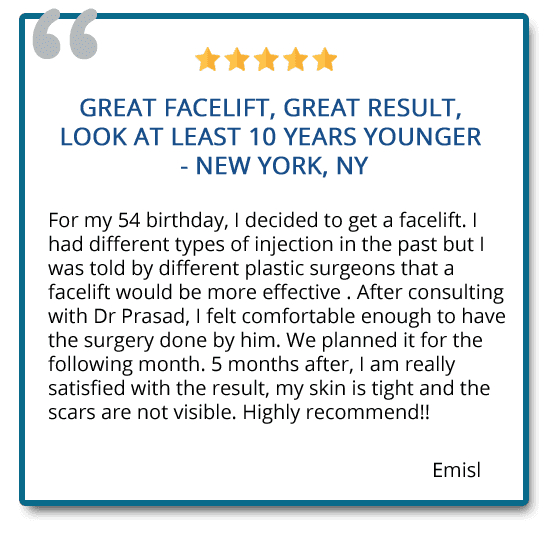
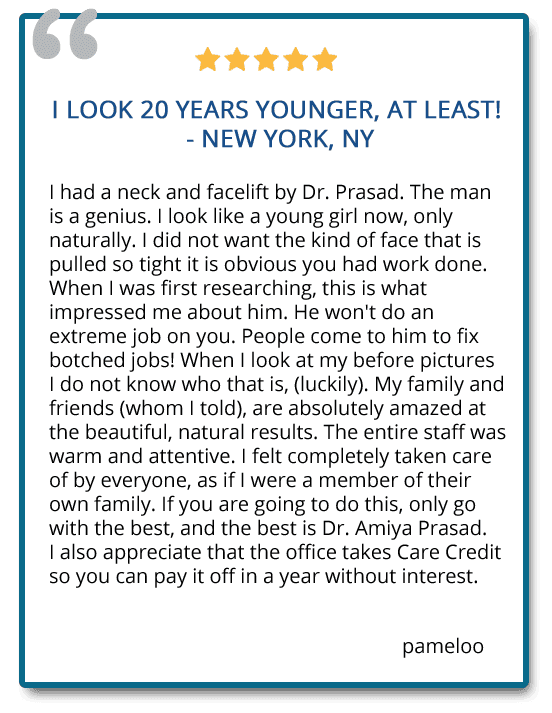
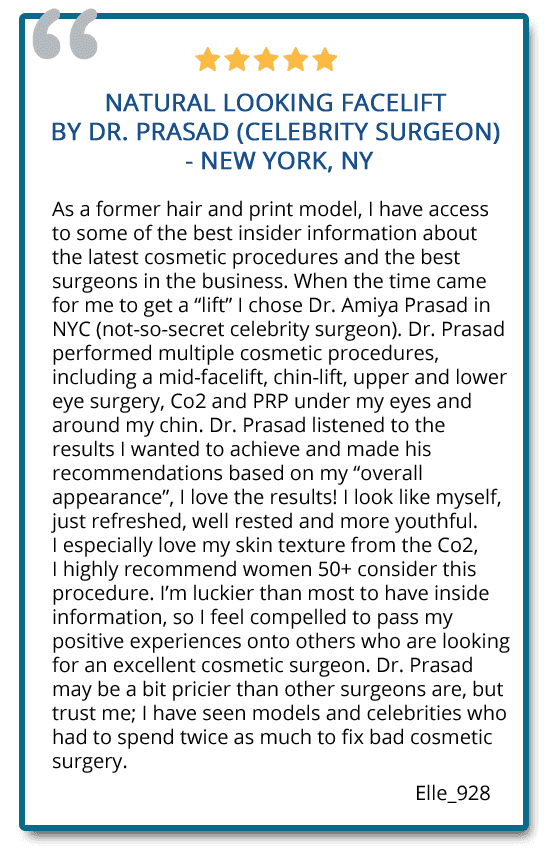
Best Facelift in NYC, and Long Island, New York
Prasad Cosmetic Surgery offers facelifts at our surgical facilities in Manhattan, New York City; and Garden City, Long Island, designed for your safety and comfort. To determine if a facelift, volume enhancement, or skin rejuvenation is right for you, an examination is needed. To schedule an appointment, call (212) 265-8877 in Manhattan, or (516) 742-4636 in Garden City, Long Island, or fill out the contact form below, and we’ll get back to you.
Appointment Request
Facelift FAQs
How much does a facelift cost?
The cost is determined individually, depending on the extent and type of facelift procedure, and accompanying procedures. Insurance does not cover any costs related to facelift or any cosmetic surgery. Contact our patient coordinator to arrange your consultation.
What is the best age to have a facelift?
There isn’t a specific “best” age for a facelift, but most of our patients are in their 60s and older. The main goal of facelift is to restore the anatomy of the sagging tissue to improve cheek position, and jawline definition. Dr. Prasad recommends facelifts, among other options like volume enhancement with Structural Volumizing depending on the needs, and age of each patient. Facelifts are done for more advanced facial aging, while significant facial volume loss usually occurs at a younger age, so every face has to be looked at individually before recommending specific procedures.
Who is not a good candidate for a facelift?
If you have minimal (younger age) or poor skin laxity (very advanced age), serious medical conditions, unrealistic expectations, or prefer non-surgical treatment, a surgical facelift is not for you. A thorough evaluation of health, skin condition, and aesthetic goals help determine if a facelift is right for someone.
How many hours does a facelift take?
Dr. Prasad’s Quick Recovery Facelift generally takes 2 to 3 hours, and is performed using local anesthesia with LITE™ IV sedation. Time of surgery varies based on the complexity of the procedure, and whether additional surgeries, like a neck lift, or eye lift are being done simultaneously.
Further questions? Or ready to take the next step to looking younger?
If you need further clarification, or are ready to schedule your consultation with Dr. Prasad, you can call us in Manhattan at (212) 265-8877; or in Garden City, Long Island at (516) 742-4636. Or you can click the button below to schedule your consultation, and we’ll get back to you

